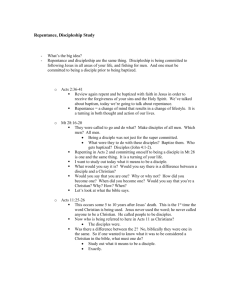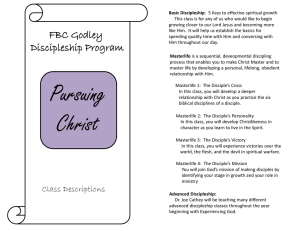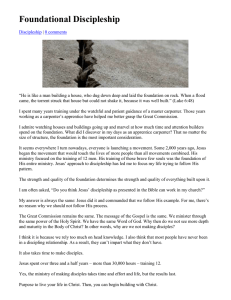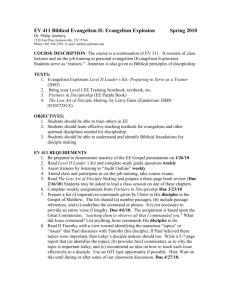unit 6: discipleship and leadership strategy
advertisement
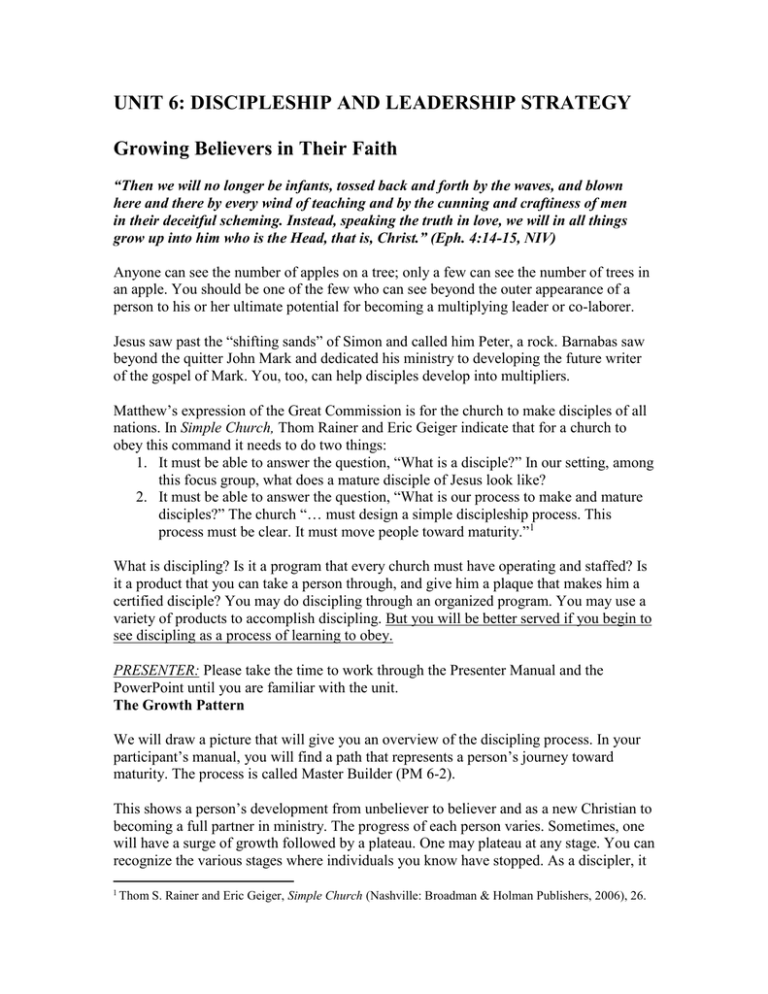
UNIT 6: DISCIPLESHIP AND LEADERSHIP STRATEGY Growing Believers in Their Faith “Then we will no longer be infants, tossed back and forth by the waves, and blown here and there by every wind of teaching and by the cunning and craftiness of men in their deceitful scheming. Instead, speaking the truth in love, we will in all things grow up into him who is the Head, that is, Christ.” (Eph. 4:14-15, NIV) Anyone can see the number of apples on a tree; only a few can see the number of trees in an apple. You should be one of the few who can see beyond the outer appearance of a person to his or her ultimate potential for becoming a multiplying leader or co-laborer. Jesus saw past the “shifting sands” of Simon and called him Peter, a rock. Barnabas saw beyond the quitter John Mark and dedicated his ministry to developing the future writer of the gospel of Mark. You, too, can help disciples develop into multipliers. Matthew’s expression of the Great Commission is for the church to make disciples of all nations. In Simple Church, Thom Rainer and Eric Geiger indicate that for a church to obey this command it needs to do two things: 1. It must be able to answer the question, “What is a disciple?” In our setting, among this focus group, what does a mature disciple of Jesus look like? 2. It must be able to answer the question, “What is our process to make and mature disciples?” The church “… must design a simple discipleship process. This process must be clear. It must move people toward maturity.”1 What is discipling? Is it a program that every church must have operating and staffed? Is it a product that you can take a person through, and give him a plaque that makes him a certified disciple? You may do discipling through an organized program. You may use a variety of products to accomplish discipling. But you will be better served if you begin to see discipling as a process of learning to obey. PRESENTER: Please take the time to work through the Presenter Manual and the PowerPoint until you are familiar with the unit. The Growth Pattern We will draw a picture that will give you an overview of the discipling process. In your participant’s manual, you will find a path that represents a person’s journey toward maturity. The process is called Master Builder (PM 6-2). This shows a person’s development from unbeliever to believer and as a new Christian to becoming a full partner in ministry. The progress of each person varies. Sometimes, one will have a surge of growth followed by a plateau. One may plateau at any stage. You can recognize the various stages where individuals you know have stopped. As a discipler, it 1 Thom S. Rainer and Eric Geiger, Simple Church (Nashville: Broadman & Holman Publishers, 2006), 26. is your responsibility to urge the people with whom you are working to keep growing. Paul urged the disciples in Thessalonica: “Finally then, brethren, we request and exhort you in the Lord Jesus, that, as you received from us instruction as to how you ought to walk and please God (just as you actually do walk), that you excel still more” (1 Thess. 4:1 NASB). Through it, you will learn the stages in the development of people from the time they become Christians until they develop into co-laborers. You will see the role you should assume, the task you should perform, and the emphasis you should make at each stage. You will get a vision for your multiplying ministry. You will understand how much responsibility you and the person with whom you work have at each stage of his or her development. You will see the importance of working with other disciples in your local church to produce multiplying leaders and, ultimately, a multiplying church. PRESENTER: Show video Miracle Meal (02:54). Ask: “How did Taylor Field reach Vaughn and disciple him into a leader.” Answer: Vaughn was first reached through a food ministry. He was taught the Word of God and how to care for others. Now he leads the outreach in the park that feeds many throughout the year. You will multiply leaders as you involve them in a ministry. No matter which ministry the Master gives you, you should multiply the leaders through discipling and equipping others. If you take people with you as you minister, you will double your ministry, because as you serve, you will train them to minister. You will become a wise disciple maker as Paul was (see 1 Cor. 3:10). Open your Bible to the first four chapters of 1 Corinthians and follow along. I. Evangelism The first stage is that of the unsaved person. Your role is that of a witness. The task is that of evangelism. First Corinthians 1:8 and 2:1-5 give clues to the development of the individuals and the roles and tasks of the disciple-maker. Someone read these verses. Paul said that his role was that of a witness and his task that of evangelism. He said that he came proclaiming the cross in simple terms. He witnessed with simplicity and directness about Christ and His crucifixion. The cross is the message of the witness. The emphasis is friendship, “Making friends for Jesus.” The witness is sowing the seed of the Word in the life of the unbeliever. PRESENTER: Contained in PM 6-3 through 6-7 are five charts that correspond to the five major steps in Disciple’s Journey. At the end of each section, encourage the participant to fill in the names of individuals that they know that fit into that category. They will start out with many names in the “Unsaved” category and will have only a few names in the “Co-laborer” category. Encourage them to continue using these charts beyond this workshop. ACTIVITY 1: Evangelism On the chart at the end of this unit, list the names of people with whom you are working who are not yet believers. II. Nurture The second stage begins when the unsaved person is born again. This point comes in a person’s life where they recognize that they are separated from God and ask Jesus to become the Savior and Lord of his or her life. The new believer is now a spiritual baby. If not helped, it is likely that they will remain spiritual babies as long as they live. That was the problem Paul pointed out to the Corinthians. The role of the discipler is like that of a parent who gives milk to the baby. Paul said, “But we proved to be gentle among you, as a nursing mother tenderly cares for her own children” (1 Thess. 2:7 NASB). What is the task? It is nurture or follow-up. Someone read 1 Cor. 3:1-3. Paul emphasized the importance of care and feeding of the new believers. We will use a baby bottle as the symbol to remind us of the task. You feed spiritual babies when they will drink. You do not force growth, but you can love the babies and concentrate on developing them as people. You want the spiritual babies to develop their full God-given potentials. The emphasis is Lordship. We are like a field in which seeds are planted and have sprouted—they are tender plants and need care. You need to be sure that the new converts have the seed of the Word in their hearts. First John 2:12-13 (NASB) says that the two things that the little children need to know are (1) that “your sins are forgiven you for His name’s sake,” and (2) that “you know the Father.” Help them understand and accept their forgiveness and sonship. Help spiritual babies grow so that they do not stop at this level. Tragically, many Christians never move beyond this stage (see Heb. 5:12-14). ACTIVITY 2: Nurture Again, list the names of people with whom you are working who are babies in Christ. They may be new Christians, or they may have been Christians for several years but have experienced little growth. III. Discipling The next stage is that of a maturing disciple. This is a very broad stage, and people are at various points along the road. John talks about little children, children, young men, and fathers in the faith (1 John 2:12-14) Your role is that of servant. At this stage, your task is training. Read 1 Corinthians 3:5-6. A disciple maker is to be a servant, not a lord or an authoritarian dictator. God is the one who causes the growth. All disciple-makers are servants. Sometimes there is more than one person involved in the discipling process, as there was with Paul and Apollos. We will use a sprinkler can as the symbol. The servant cannot cause growth, but his task is to enhance the climate for growth and fruitfulness. (An optional passage is Luke 13:6-9.) The three areas of growth that need to be given attention at this stage are: 1. Knowledge: There are various truths the disciple needs to understand. 2. Skills: It is not enough to simply be instructed in the truth, but the disciple needs to know how to apply these truths to life. 3. Character: The truth needs to be internalized so that character is transformed. The emphasis at this stage is Discipleship. The fruit-bearing tree is the symbol of the spiritually mature disciple. ACTIVITY 3: Discipling Again, look at the chart and identify the people whom God has brought to you who are maturing disciples. Those who are consistently growing in the Lord. They may be part of your church planting team. IV. Equipping The next stage is that of multiplying leaders. You might think that when a person reaches the spiritual disciple stage, the discipleship process is completed and the final goal is reached. Not so. Unfortunately, too few disciples go on to become multiplying leaders. Be careful not to level off here. Look at your own life. Have you leveled off in your personal growth as a disciple? You may need your mentor to help you move forward to the next stage. Your role as the discipler is important here. Your role is that of a steward. You are not their master. Your task is that of equipping the fellow servants. Read 1 Corinthians 4:1. Look at Luke 12:42-47. Jesus uses the word “steward” in a parable. The steward of New Testament times had the responsibility of overseeing an entire household for the owner. As a steward, you have the privilege of feeding, assigning tasks, and equipping other servants. You are not the owner of the household, but a servant who serves servants. Now read 1 Corinthians 3:10-16. It appears that Paul was linking the steward role to the analogy of the builder who builds on the foundation. We will use a stone mason’s trowel as the symbol of this role. Those who build on the foundation bear a great responsibility. As a steward builder, you are to select the right materials to build on the foundation. The foundation of Christ is wide enough and deep enough for a spiritual temple of any size. The hay, wood, and stubble mentioned here are not bad building materials for ordinary houses, but you are not building an ordinary house. This spiritual temple must stand the test of the fire of God’s judgment. The Amplified Bible says, “The fire will test and critically appraise the character and worth of the work each person has done” (1 Cor. 3:13). The gold, silver, and precious stones represent the things of eternal value. Fire will not destroy them. Fire may melt the gold and silver and burn out the dross and change the shape of them, but they will not be destroyed. We must build lives that stand the test of eternity, not just a few months or a few years. Set high standards for you and for your disciples and keep them so that succeeding generations will continue to build holy temples. As you equip multiplying leaders, accept your responsibility to help the disciples develop basic convictions, sound doctrines, and principles of living that will stand any test. The emphasis in this area is Leadership. Now the spiritual disciple begins to multiply. Let’s picture the seed of the fruitbearing tree as new trees growing up beside and under the shadow of an older tree. ACTIVITY 4: Multiplying Leaders Again, look at the chart and identify the people whom God has brought to you who could become multiplying leaders. These are disciples who could move to the next level. V. Supporting The last stage is that of a co-laborer. The role of the disciple maker at this stage is encourager and the task is supporting. Read 1 Corinthians 3:7-9; 4:6, 17. Paul and Apollos were co-laborers. One was not greater than the other, although Paul helped Apollos in his early ministry. They worked together to disciple and to equip disciples at Corinth. There is a sense in which Timothy was Paul’s “son in ministry”, but Paul also saw him as a full partner in ministry. The symbol of this stage is the oxen yoke. The role of the discipler at this stage blends with that of the disciple as you encourage him. You are to support the other person’s ministry. God desires many co-laborers in the church who, together, can produce multiplying leaders. No one does it by himself or herself. This is why the local church is the best environment for making disciples and disciple makers. Once you have led someone to Christ, you do not abandon your responsibility as a parent. Parents do not teach their children everything that they will know, but they are responsible to see that their children have the right kind of training and experiences. Help your disciples benefit from the ministries of your co-laborers in your state convention and/or association’s training events. Some may be helped by advanced training courses in college and/or seminary. As co-laborers, your disciples probably will move forward to establish their own ministries, as did most disciples of Jesus and Barnabas. Are we willing to risk raising up co-laborers? Barnabas took a chance with Saul. They started on the first church planting project as Barnabas and Saul (Acts 13:2) and became Paul and Barnabas. Barnabas did not seem threatened with Paul’s ascent from second to team leader. Are we comfortable with raising up leaders who can stand shoulder to shoulder with us? What about raising up a leader who surpasses us? The emphasis at this point is Partnership in ministry. The final picture is an orchard, all trees standing together and bearing fruit. ACTIVITY 5: Co-Laborers Again, look at the chart and identify the people whom God has brought to you who could become co-laborers. These are disciples who could be led to plant a new church. ACTIVITY 6: Strategy for Making Disciples 1. In your church planting team, define a disciple of Jesus. What does a mature follower of Jesus look like? 2. What is our process of helping others move toward maturity? 3. Discipleship Foundations—One Year Calendar Plan is designed to help you think through this process and develop a comprehensive strategy for making disciples. Look at the variety of resources listed from LifeWay and other resources. Think about others that you know of. What process and resources do you need to plan to use in growing believers toward maturity in the church God is calling you to plant? (PRESENTER’S Note: The following material is in the PM for their reading and is not designed for coverage in the workshop.) I. Guidelines to Help You Grow Believers in Their Faith Here are a few guidelines to help you become a wise Disciple Maker. A. As the person develops, he or she should be encouraged to help a person who is going through the stage he or she has just completed. Passing on what one has learned is the best way to make it a part of one’s life. B. You could be helping different people at each stage simultaneously, although your main ministry may be emphasizing one stage. Do not spend all your time with people who are at the higher stages. Many disciplers do and they lose their effectiveness. You are the model for the people you are training. If you are not witnessing on a regular basis, the disciples or leaders you are training will tend to follow your example. As you help your disciples develop, encourage them to relate to individuals at every stage they have already passed through. C. As your disciples show more interest, give them more time and help. The natural tendency is to neglect the growing people to help those who are not growing. Focusing on one who is growing produces multipliers and co-laborers to help with those who are not growing. Guidelines A and B are complementary truths that need to help balance your work and keep you from getting stuck in a ditch on either side of the pathway. D. You are not the only determining factor in the process. God, the people involved, the materials you use, the discipling group, the church, and the environment play vital roles in believers’ development. Consequently, you should not claim all the credit for success. Neither should you feel completely responsible if a disciple fails to develop. E. You do not work alone. You should work with your co-laborers to help people become all God intends for them to be. F. Keep your vision of what God wants to accomplish through you, through those you train, and through the new church you are planting. Keep looking at the need and look beyond it to the purpose of God. Be faithful. “Behold, the farmer waits for the precious produce of the soil, being patient about it, until it gets the early and late rains. You too be patient; strengthen your hearts, for the coming of the Lord is at hand” (James 5:7-8 NASB). G. As a wise builder of disciples, you will find yourself working with people at every stage of development. Some of those you help may surpass you in ministry, as Paul did Barnabas. What will be your attitude as a proud parent, servant, steward, and colaborer? Will you will rejoice with them and thank God you have been successful? John said, “I have no greater joy than this, to hear of my children walking in the truth” (3 John 4 NASB). II. Practical Steps for Developing Leaders. 1. Observe the gifts of those in your core group and select them for training. 2. Cultivate those with potential. 3. Concentrate on those with the greatest potential. 4. Model leadership in all your actions. 5. Create a plan of studies for each of your leaders. 6. Adopt a hands-on training program with your supervision. 7. Empower them with your trust, and always encourage them. 8. Hold on to high expectations for each of the potential leaders. 9. Meet with them periodically to exchange ideas. 10. Evaluate where they are in the process on a monthly basis. 11. Have them participate in workshops and other training activities. 12. Ask them to teach what they have learned to other potential leaders. Personal reflection: Take stock of where you are in your own development as you examine the Disciple’s Journey picture. Where are you? Do you need to move up a stage? Have you skipped a stage or failed to develop fully as you should? For example, did you really become a spiritual disciple before becoming a multiplying leader? If not, has it resulted in some flaws in your leadership? Are you helping people at all of the stages that you have already passed through? If so, are you exhibiting the appropriate attitude of the discipler relative to those stages? Are you assuming the proper amount of responsibility and expecting others to grow in the amount of responsibility they accept? If God’s fire of judgment were to test your work today, would you have enough gold, silver, and precious stones invested in building others? As you examine what you have done to date, will you commit yourself to help people come to know Christ, to follow up, disciple, and equip them until they become multiplying leaders and co-laborers? RESOURCES Howard and William Hendricks. As Iron Sharpens Iron. Chicago: Moody Publishers, 1999. Sue Mallory. The Equipping Church. Grand Rapids, Mich.: Zondervan, 2001. Sue Mallory. The Equipping Church Guidebook. Zondervan, 2001. Max DePree and James O’Toole. Leadership Is an Art. Broadway Business, 2004. Samuel D. Rima. Leading From the Inside Out. Grand Rapids, Mich.: Baker Book House, 2000. Robert E. Coleman and Billy Graham. The Master Plan of Evangelism 2nd ed. Grand Rapids, Mich.: Fleming H. Revell, 1994. Bobb Biehl, Mentoring. Nashville: Broadman and Holman, 1997. Discipler’s __________ Role 1 Cor 1:18 1 Cor 2:1-5 Task GOD __________ __________ __________ __________ 1 Cor 3:1-3 1 Cor 3:5-6 1 Cor 3:7-9 1 Cor 4:6, 17 __________ __________ __________ __________ __________ ..:....:... Emphasis 1 Cor 4:1 1 Cor 3:10-16 Friendship Lordship Discipleship .::.:: …..:.:.. ... Leadership .:.:.:.:.:.: ::::. ::::: ::.::.:.::: Partnership Disciple’s Journey – Master Builder Name - Unsaved Action Resource Name – Spiritual Baby Action Resource Name – Maturing Disciple Action Resource Name – Multiplying Leader Action Resource Name – Co-laborer Action Resource Discipleship Foundations – One Year Calendar Plan September/October Spiritual Baby Maturing Disciple Multiplying Leader November/December January/February March/April May/June July/August RESOURCES for DISCIPLESHIP Character—Developing spiritual disciplines to aid us in maturing (or being) who we are in Christ as stated in Ephesians 4:13. Knowledge—Discovering what we need to know as believers who are growing up into Him who is the Head as stated in Ephesians 4:14-15. Skill—Developing the ability to do those things essential as coordinated and effective servants of Christ, the church, the community, and the world as stated in Ephesians 4:16. CHARACTER The BodyLife Journey (N/A) Survival Kit (6) Taking the Next Step (4 or 5) MasterLife I (6) Disciple’s Prayer Life (13) Search for Significance (8) In God’s Presence (6) Breaking Free (11) Every Christian a Minister (4) God’s Story (5) Jesus by Heart (6) My Identity in Christ (6) Walking by Faith (7) KNOWLEDGE Confronting Life Issues (13) The 5 Love Languages (2, 5 or 7) Foundations of the Faith (6) Your Life & Your Church (7) Experiencing God (12) MasterLife 1 & 2 (6 each) The Mind of Christ (12) Parenting by Grace (10) Seven Seasons of a Man’s Life (6 each) A Woman’s Heart (11) How Much Is Enough? (4) Money In Marriage (6) Biblical Financial Study, Crown Financial Ministries (10) Breaking Free (11) SKILL Day by Day in God’s Kingdom (12) Living God’s Word (6) Experiencing God in Your Workplace (6) MasterLife 3 & 4 (6 each) Men Leading the Charge (8) The Mind of Christ (12) Share Jesus Without Fear (4) Woman to Woman Mentoring (6 months) F.A.I.T.H. (12) Men’s Fraternity-The Great Adventure (20) Mom to Mom: Heart Talk on What Really Matters (12) Jesus on Leadership (6) On Mission with God (8) www.lifeway.com (Discipleship Resources Index) www.Serendipityhouse.com __________________________________________________________________________________________ OTHER RESOURCES (These are shared for information, not endorsement.) www.saddlebackresources.com www.navpress.com www.churchgrowthinternational.com _________________________________________________________________________________________ ADDITIONAL RESOURCES:
